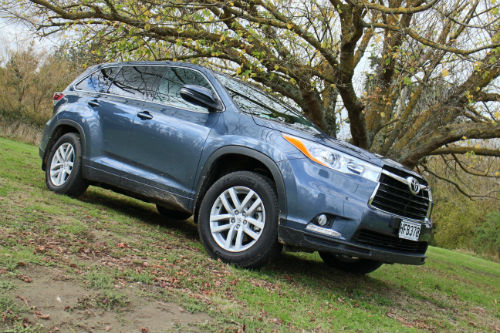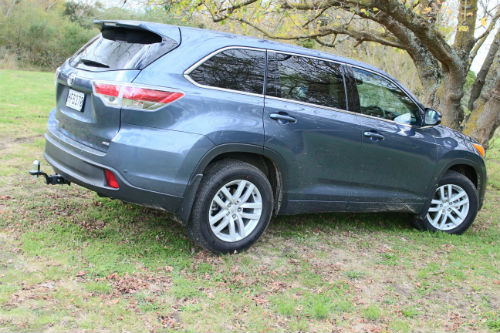Wednesday May 14, 2014

By Richard Bosselman
Pros: Classy looks, capacious interior, seven seater appeal, high level of refinement.
Cons: Petrol-pure approach risky now, not cheapest choice, hateful parking brake, over-sensitive stability control.
Road test rating: 3.7/5
ALL those shoals of Corollas and Camrys would suggest Toyota didn’t get where it is today by bucking trends, yet that’s not really true.
There are all manner of cars in the history of Japan’s No.1 that were, at the time, real risk-takers: The first MR2, the original RAV4, the Hilux at birth … and the car tested here.
No, really. The Highlander is the mainstreamer that is conceivably outside the square in respect to fuel choice. All sorts of customer preference data shows that the vast majority of sports utility buyers enjoy diesel; basically, the bigger the vehicle, the more likely they are to prefer dining at the dark side of the forecourt.
Toyota New Zealand knows this, but prefers not to make a big deal of it, and because this Highlander (like the last) doesn’t ‘do’ diesel, for the simple reason that the model was designed for the United States, where petrol is king. Now that the new model is also only built there, the case for breaking this habit becomes even harder to prove.
Meantime, almost all of Toyota’s rivals in the medium category – save for Nissan because their Pathfinder is also only made in America now – are staking their futures on diesel.
Yet Toyota New Zealand reckons they’re not sweating it: Size, solidity and, now, status as a pure seven-seater offering will all ensure a continuing clientele, they say. Tested here is the GX all-wheel-drive, at $59,990 the range’s entry point.
Design and engineering:
Rating: 3.5/5
Here’s a Highlander that paints itself blue and come charging through the SUV battleground swinging a giant broadsword and yelling terrible oaths. Well, sort of. What we mean is that the styling, now, is bolder than it was before.

The exterior metalwork is wholly altered, and though the size, general shape and silhouette remains a constant, the numerous detail changes cumulatively amount to a brasher air, not least around the front.
Speaking of that face. You’d have to wonder if one of the design chiefs has a thing for horn-rimmed glasses. Look dead on at the Highlander’s face and you’ll surely see what I mean.
So it’s bold, though not uncomfortably so. Those protruding flat-topped headlights and taillamps – plus the extra creases and corners - are a Toyota-wide styling signature that doesn’t look wrong here.
Powertrain and performance:
Rating: 3.7/5
All Highlander models use a 3.5-litre petrol V6 engine producing 201kW at 6200rpm and 337Nm at 4700rpm. It’s a carryover from the preceding range.
In both the front-wheel drive and all-wheel-drive models an Aisin-supplied six-speed automatic gearbox replaces the old five-speeder, helping fuel consumption improve by around eight percent to 10.2 litres per 100km in the former and 10.6L/km in the latter configuration.
Really? Yeah, well, the official figure for the all-wheel-drive seemed ludicrously optimistic on test. Committed to a good mix of open road and urban driving, the test car finally settled at a 12.4L/100km average, but at times was far greedier. The lack of direct fuel injection bluntens some efficiency opportunity, but overall this performance suggests Highlander owners will find it no easier to justify this car on grounds of economy.
Driver appeal:
Rating: 3.2/5
IF you’re comfy with the petrol thing, still prefer a Japanese badge and have something of a budget to stick to, then cross-shopping becomes dead simple, because really there’s just this car or the Pathfinder. So thereon you’re matching same-sized engines, similar sized and outfitted models and two transmission types: Constantly variable transmission with Nissan versus an orthodox auto for Toyota.
It’s no contest. The Highlander is the superior being. The gearbox is part of the attraction; cog-driven action is just so much more reactive and smoother than the CVT experience. The suave and unfussed nature of this box is such that, in many instances, the change points are all but imperceptible.
The transmission’s main aim is to bring more good from an engine that, as the almost unaltered outputs remind, is a massaged carryover previously known for its strong, lazy tune and output.
The switch to a six-speeder makes it feel a whole lot newer. You’ll sense that it is a touch nippier off the line, but it’ll be better appreciated for being especially refined.
Regardless of its quiet mannerisms, this transmission is tuned for active participation, yet only to a point. The inclusion of a manual shift to allow that extra level of control is good, but in all probability it’ll be hardly over-used. You just don’t feel the need.
That’s interesting given that, like all V6s, this one doesn’t like to be all torque and no play. It expects to be meted a decent dollop of revs to really get going – peak muscle doesn’t emerge until 4700rpm and it needs to be in the meat of it to shift this two-tonne bodyweight. Yet even then it’s not especially shouty.
The car’s size reflects in its weight, which clocks in between 1935kg to 2065kg. Yet it is spritely, requiring between 8.3 and 8.7 seconds to hit 100kmh from standstill, on the way to an 180kmh top speed.

Ride, refinement and quality:
Rating: 3.6/5
The suspension tune here is said to be firmer than is experienced in America; the models sold here benefit from Toyota Australia having retuned the US-market spring-damper set and the electric power steering so that it will hold the road more precisely, sit more comfortably on gravel and communicate more directly to the driver.
A new compact double wishbone rear suspension system replaces less sophisticated trailing arms and an increase in mounting rigidity for the front MacPherson strut suspension is also a positive step.
The risk with making an SUV too dynamically entertaining is the compromise it can bring in terms of comfort; Toyota has not fallen into that trap. The balance between body control and ride quality is quite obviously carefully judged. Yet it does seem to strike a good compromise; it possibly loses points to that certain other rival for bump absorption and pliancy, but in turn provides a more resolved ride and less body roll. The recalibrated electric steering takes Toyota ahead; it’s not overwhelming for actual ‘feel’, yet the usual overly light vagueness has been eradicated for a steadily progressive system that has more weight than most.
Switching production away from Japan – where seamless quality is always a given - to the US might have you bracing for the potential for misaligned panels or glossy plastics, but don’t fret. The base materials are obviously chosen foremost for their ability to withstand knocks and abuse, but the closest to cheapo plastic within the cabin is kept well out of sight and finish is pretty good.
The dashboard and interior are nicely drawn and made; the impression of superior quality is also raised by extensive use of soft touch fascia materials, a Lexus-like stitched look to the upholstery and chrome accents. The only jarring note – and it’s a biggie – is Toyota’s insistence on continuing with a foot-operated park brake: It’s awkward, it’s old-style … it should be outta here.
If you want true luxury, the GX is at the wrong end of the range; the top of the range ZR takes Highlander specification to almost Lexus level, but that’s the best part of $30k away from this price level. The GX has a centre screen with slightly weird touch-pad buttons that is designed to be a multifunction portal but not here: Bluetooth, a basic trip computer and audio controls are your lot, and the display really seems under-utilised as result.
Practicality and packaging:
Rating: 3.9/5
The model’s upsize isn’t quite what it seems; while the wheelbase and tracks have extended slightly, really the additional bulk is more down the overhangs having been lengthened and the body widened a smidge; pushing the A-pillars forward at the base also enhances the impression that this is a bigger edition.

The controls are placed to international Toyota 101 logic but the US-centric touches show in good ways and bad. A ‘conversation’ mirror and a central roll top console bin the capacity of a small chilly bin (though, being uninsulated and lacking a chilling function, it’d be of little use for that) are intriguing, but I’m lost as to the full usefulness of the ledge that spans the centre console. It’s odd-shaped and narrow that even a cellphone seems to precariously balance (and rattle, too, as there’s no soft padding here).
As a seven-seater, it comes on strong: The front chairs are the primo spot, but the second row is perfectly agreeable for two adults or three smaller types and even the last rank would, at a pinch, work for a pair of average-sized adults. Occupants don’t lack for head or legroom and there’s a goodly count of cupholders and other amenities. As is usual, the boot doesn’t start to look truly spacious until that third row is folded away. Knock down the second row and it does a reasonably good impression of a low-roofed van.
How it compares:
You’d have to think that private buyers would nowadays find this car easier to accept where it equipped with the engine type that propels the bulk of NZ SUV volume, yet the Highlander’s steady and impressive sales show a different truth.


